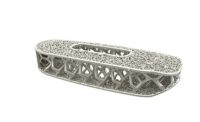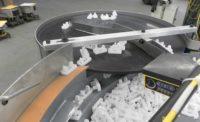For Flex, there isn’t a question of what can’t they do, but what they will do next. The 50-year-old company began manufacturing electronic products, something it still does today, but has expanded to offer end-to-end production across the globe.
Flex, formerly Flextronics, dropped the “tronics” to show customers that they can offer more than traditional electronic manufacturing services. Flex has shifted its focus to new technology and advanced manufacturing, and Revathi Advaithi was named Flex’s first female CEO in February 2019. The company has rebranded as an end-to-end partner, with the resources for every step of production.
With over 50 million square feet of manufacturing space at 106 sites in 30 countries, Flex has a significant global footprint. This is thanks, in part, to its acquisition of other companies, including a few competitors. Another key to Flex’s global success is the ability to leverage its knowledge about one industry into another. Currently, Flex manufactures medical, automotive, appliance, solar, telecom and electronics products for 1,000 different customers.
In recent years, Flex has expanded its offerings beyond manufacturing. Product design assistance has become a frequently requested service, so Flex now offers Sketch-to-Scale, a program that takes a product from the very beginning stages of design through manufacturing. Flex has 25 dedicated design centers and nearly 3,000 engineers working on design.
Mike Doiron, chief technology officer of advanced engineering, sees offering design services as a natural progression.
ASSEMBLY: Flex seems to place a lot of significance on design. Are you moving away from manufacturing to focus on design?
Doiron: We’re not really looking to do design for the sake of design—we do design as an enabler to win that volume business. Customers had asked about product design and who better to ask than someone who does this every day.
Our focus on design is for manufacturability—how can we design this product to be produced in a more efficient way. At the end of the day, we are a manufacturing company, the design piece is an enabler to volume manufacturing.
ASSEMBLY: Flex has a hand in nearly every industry and manufactures a huge variety of products. Is there any type of manufacturing that you do the most?
Doiron: It really depends on the customer. We’re still an electronics manufacturer, plus everything else to enable it to an end product. Surface-mount technology (SMT) is the core business, quickly followed by plastics and metal, and then machining. We have almost 2,000 injection molding machines world-wide and 17 key sites that do just plastics. For metal fabrication and forming, we have 10 sites with hard and soft tooling and stamping machines.
But we’re getting into other types of manufacturing too. As things get miniaturized, we're doing more microelectronics. We now have the design capability for system-in-package in microelectronics that allows us to make micro components for our customers. System-in-package has been around for a while, but it’s not something EMS providers did.
Now we're doing some of that and we have our own design capability. Our team recently designed an Internet of Things module which allows productivity in a very small footprint, about 10 millimeters by 10 millimeters. We do the whole system-in-package design and manufacturing ourselves.
So, that scaling toward microelectronics, is something we’re excited to be able to offer.
ASSEMBLY: On the subject of different industries, how has Flex been successful in so many?
Doiron: It’s interesting because as soon as you start building in one of these industries, it lends itself to a skillset that you that you can leverage in another industry. A lot of these industries are tangential, but by starting in one it got us a foot in the door to another.
One of the things that Flex is very good at is getting involved in new technology, learning the hard way as most people do, but then excelling and going beyond to become a subject matter expert.
We did that with the solar industry. Where we started out, we had never built a solar panel before but within no time we’re building for all the major solar players. We did the same thing in the medical field by hiring people with medical industry and design experience to work with our manufacturing experts.
To be able to operate in all those different spaces, we can’t look at those spaces as independent. We have to be able to leverage our skill set and our manufacturing capabilities across those industries, otherwise we’re not going to get the return on investment and our capital.
ASSEMBLY: Is there one particular industry that presents the most challenges?
Doiron: Every industry has its own little idiosyncrasies of complexity. In some cases it’s a reliability issue, while in others it’s a precision issue, of whether it can even be built.
The automotive industry was interesting, and one that caused us a bit of pain when we started, but we’ve gotten to the point where we're leading industry experts. The challenge of the automotive industry was that once the customer picks a supplier, they generally want that supplier to be around for many life cycles of the product.
Additionally, customers might want you to develop and put in place a manufacturing capability up to a year before the launch of the product because of all of the qualifications that they need to meet. But we’ve gotten to the point now where we’re doing many design elements for the automotive industry and additional value on the autonomous vehicle side.
ASSEMBLY: What has been the biggest manufacturing challenge?
Doiron: I would say everything’s been sort of incremental, but one of the big learning curves was automation. Early on in our evolution of learning how to automate, we were automating processes that were not first “leaned” out. We learned that if you start with an inefficient flow or manufacturing process, what you’re trying to automate will be a very expensive boat anchor.
So what we’ve done over the last 10 years is a convergence of groups that were not previously combined: lean, quality and automation. What that allows us to do is send in our lean industrial engineers and quality teams to work with the automation guys to lean this process out before we try to automate it.
Lean, quality and automation are traditionally very different skill sets, but having them under one roof and managed by one management team has caused us to really accelerate our value, improve our margins and add value for the customer.
ASSEMBLY: Where does sustainability fit into manufacturing?
Doiron: We are very conscious of sustainability. We’ve been successful in terms of renewable energy because we had that capability to manufacture solar panels of our own design. We have a pretty significant square footage of solar panels on many of our production facilities, so taking that reusable energy and using it there has been a great.
On the scrap side, we have significant programs generating large savings. In Brazil and Mexico, we have entire facilities dedicated to recycling plastics and metal for use in manufacturing and selling ground plastics that we can’t use back to the industry.
We have even taken plastics from our facilities that wasn’t usable in new manufacturing and ground it to make recyclable bins used to move product within our facilities. The recyclable bins are made with old plastics from injection molding. We use these bins for shipping product to and from customers and suppliers.
ASSEMBLY: You’ve also found a way to make automation “recyclable” as well?
Doiron: So one of the things we’ve done is developed and design our own Flex robotics cells we call the FRC, now manufactured by one of our offshoots, Bright Machine. These robotic cells are capable of being quickly deployed and quickly repurposed.
Years ago, the systems we automated were not easily redeployable or reusable for another customer. So if the customer went away or that product ended life, we were stuck with a very expensive piece of automation. Now, we’re developing flexible robotic cells that [can] dispense an adhesive one day and then, a few months down the road, [shift] to doing auto screwdriving or mechanical pick-and-place over complex geometry.
Having these robotic cells that are Flex-owned and Flex-designed has given us tremendous flexibility and the ability to leverage the return on investment.
ASSEMBLY: What does the future hold for Flex?
Doiron: What you’re going to see for us is a lot more use of data. What I mean by that is, we collect a lot of data, and we want to be making intelligent decisions using that data to improve our processes. So, machine-to-machine communications, better machine learning and use of data basically are the future for the advancement in our industry.
We’re driving a lot of efforts on simulation, like simulating production flow before we put in a production line. Connecting the virtual simulations to another technologies like virtual reality headsets to show a customer the output of a simulated production line before we build it. It is really powerful to walk a customer through the product line virtually, and it lets us work out potential issues and challenges before they can actually occur.
So the future at Flex is the convergence of all things machine learning, from the use of data to virtual reality.





